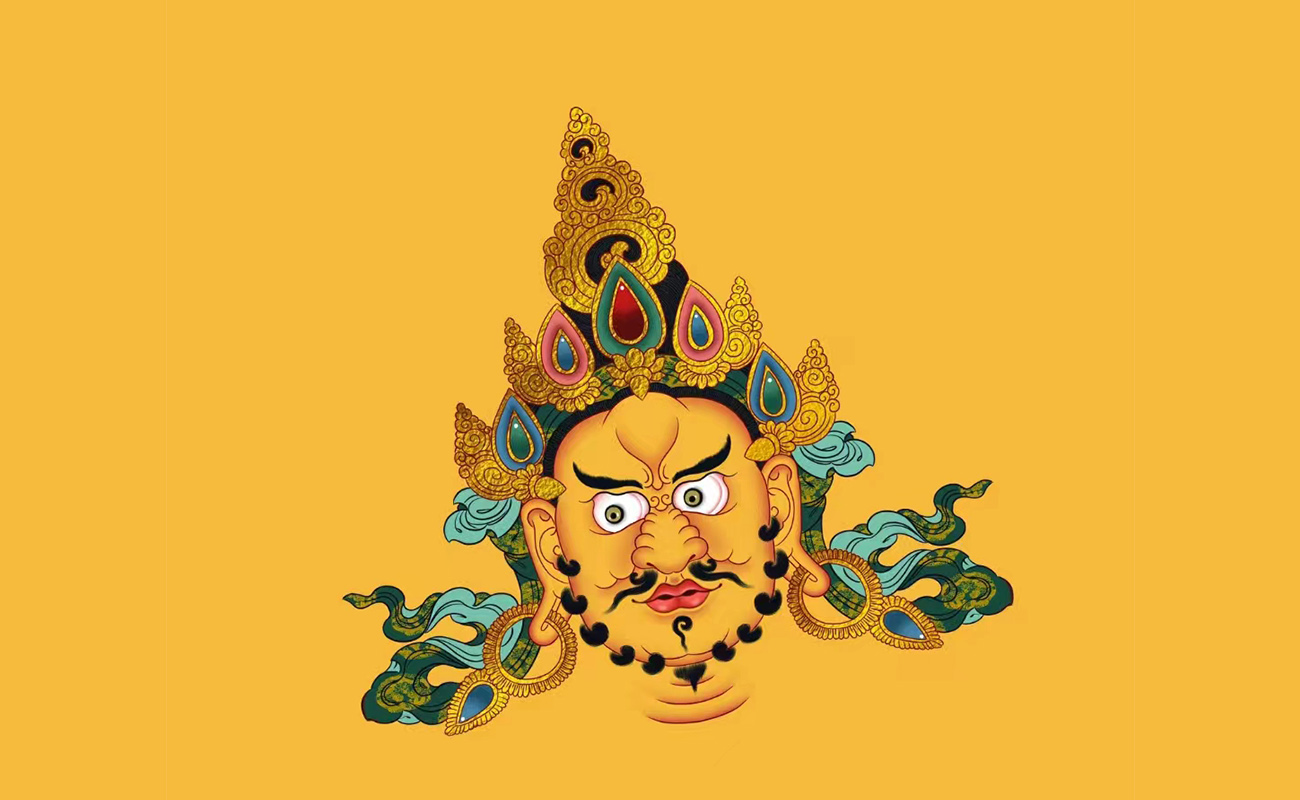In the realm of Tibetan Buddhism, the spiritual landscape is adorned with a pantheon of deities, each carrying distinct attributes and offering unique blessings. Among these divine beings, the wealth deities stand out as patrons of prosperity, abundance, and the removal of obstacles. This article delves into the fascinating world of wealth deities in Tibetan Buddhism, shedding light on their significance and roles in the lives of practitioners. We’ll explore the following five prominent wealth deities:

1) Jambhala: The Bestower of Wealth
Jambhala, also known as Dzambhala, is a beloved wealth deity in Tibetan Buddhism. With a radiant countenance and a joyful disposition, Jambhala is revered as the bestower of wealth and prosperity. This deity is often depicted in various forms, each symbolizing different aspects of wealth, such as material abundance, spiritual riches, and the wealth of wisdom. The practice of Jambhala involves invoking his blessings to overcome financial difficulties and attain a life of affluence and generosity.
The Many Forms of Jambhala
Jambhala takes on several forms, including:
- Yellow Jambhala (Dzambhala): The most commonly worshipped form, associated with increasing wealth and prosperity.
- White Jambhala: Known for purifying obstacles and enhancing one's wisdom.
- Black Jambhala: A fierce form that protects against harm and negative influences.
- Green Jambhala: Revered for healing and longevity.
- Red Jambhala: Bestows power, authority, and success.
Devotees of Jambhala engage in rituals and recite mantras to invoke his blessings, seeking financial stability and the ability to contribute positively to the world.
2) Vasudhara: The Goddess of Abundance
Vasudhara, the goddess of abundance and fertility, is another prominent figure in Tibetan Buddhism. Her name translates to "stream of gems," signifying the flowing nature of wealth and prosperity. Vasudhara is often depicted holding a sheaf of grain, symbolizing agricultural abundance, and pouring forth jewels from her hands.
The Symbolism of Vasudhara
Vasudhara's blessings extend to various aspects of life:
- Material Wealth: She is invoked to bless devotees with financial success and abundance.
- Fertility: Vasudhara is sought after by those wishing for children or agricultural prosperity.
- Spiritual Growth: Her association with jewels and grains symbolizes the inner wealth of wisdom and compassion.
Devotees turn to Vasudhara in times of financial hardship or when seeking growth in both material and spiritual dimensions.
3) Vaishravana: The Guardian King of the North
Vaishravana, also known as Kubera, is one of the Four Guardian Kings in Tibetan Buddhism. As the guardian of the north, Vaishravana protects the teachings of Shakyamuni Buddha, specifically safeguarding the Vinaya teachings and those who practice self-discipline.
Vaishravana's Attributes
- Golden Armor: He is often depicted wearing golden armor, symbolizing his protective role.
- Mongoose: In his left hand, Vaishravana holds a mongoose that spews forth jewels, representing his ability to bestow spiritual and material wealth.
- Closed Mouth: Due to the harmful nature of his breath, Vaishravana keeps his mouth tightly closed.
Vaishravana's presence at temple entrances and his role as a guardian of the Dharma highlight his significance in Tibetan Buddhism.
4) Ganapati: The Remover of Obstacles
While Ganapati is commonly associated with Hinduism, his presence extends to Mahayana Buddhism as well. Ganapati serves as a Yidam, a Dharma protector deity, and more, helping practitioners overcome obstacles and achieve their goals.
Ganapati's Versatility
In Mahayana Buddhism, Ganapati assumes various roles:
- Yidam: A meditational deity bestowing blessings for success.
- Dharma Protector: A guardian of the teachings.
- Obstacle Remover: Assisting in surmounting challenges.
Ganapati's universal appeal transcends spiritual boundaries, making him a widely recognized and beloved figure even outside religious circles.
5) Yellow Tara: The Radiant Bestower of Abundance
Yellow Tara, also known as Golden Tara or Ekajati, represents the embodiment of enlightened compassion and wealth. With her golden complexion, Yellow Tara symbolizes radiance and the removal of obstacles, both material and spiritual.
Yellow Tara's Attributes
- Golden Complexion: Her radiant appearance signifies her illuminating nature.
- Golden Vase: In her right hand, she may hold a golden vase symbolizing abundance.
- Blue Lotus: Her left hand often holds a blue lotus, representing spiritual purity and wisdom.
Devotees turn to Yellow Tara to seek her blessings for prosperity, abundance, and the elimination of hindrances.
Conclusion
In Tibetan Buddhism, the worship of wealth deities is not driven by mere materialism but by the desire for a prosperous life that allows one to make positive contributions to the world. Jambhala, Vasudhara, Vaishravana, Ganapati, and Yellow Tara each play a vital role in fulfilling these aspirations. Whether it's financial stability, spiritual growth, or the removal of obstacles, these wealth deities offer their benevolent guidance to practitioners seeking abundance in all aspects of life.
Frequently Asked Questions
Who are the primary wealth deities in Tibetan Buddhism?
In Tibetan Buddhism, several wealth deities are revered, including Jambhala, Vasudhara, Vaishravana, Ganapati, and Yellow Tara. These deities are invoked for various aspects of wealth, prosperity, and the removal of obstacles.
What is the significance of worshiping wealth deities?
Worshiping wealth deities in Tibetan Buddhism is not solely about material wealth. It encompasses spiritual wealth, compassion, wisdom, and the ability to contribute positively to society. These deities help practitioners achieve a balanced and abundant life.
How can I connect with wealth deities for blessings and guidance?
Connecting with wealth deities involves practices such as meditation, mantra recitation, and rituals specific to each deity. Devotees seek their blessings by offering prayers and invoking their presence to overcome financial difficulties or attain spiritual growth.
Are these wealth deities exclusive to Tibetan Buddhism?
While these wealth deities are prominent in Tibetan Buddhism, some, like Ganapati, have roots in Hinduism. However, they have been incorporated into Tibetan Buddhist practices and hold a significant place in the spiritual lives of practitioners from various backgrounds.
Can I worship multiple wealth deities simultaneously, or should I choose one?
It is common for practitioners to connect with multiple wealth deities simultaneously. Each deity represents different aspects of wealth, abundance, and prosperity. You can choose to invoke the blessings of the deity that aligns with your specific goals or seek guidance from multiple wealth deities for a holistic approach to abundance.
These FAQs provide insights into the role and significance of wealth deities in Tibetan Buddhism, helping practitioners understand how to incorporate these divine beings into their spiritual journey.
Regenerate









